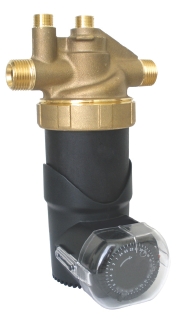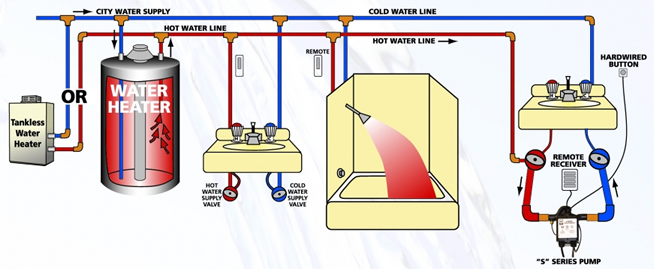
Hot Water Recirculation Pumps
Save over 10,000 gallons a year (the manufacturer claims up to 17,000) by installing a hot water Recirculation Pump. This pump makes hot water more quickly available everywhere in the home, thereby reducing the wait for hot water (and thus the savings by not letting all that cold and warm water go down the drain while waiting for hot water).
Hot water recirculation pumps can be located either at the water heater itself, or at a point of use (fixture) in the building, and either timer aquastat driven or on demand & aquastat
Pump at the water heater (dedicated return line)
Pumps located at the water heater are suitable for installations with a pre-installed hot water return line. The building's main hot water line is kept primed with hot water without pushing any hot or warm water into the cold water supply. However, hot water supply branches from the main supply line to individual fixtures are not kept hot, and there will be a short delay while this water is purged when the hot water tap is turned on. This type of installation is more common in new buildings.

Pump at a point of use
Pumps located at a point of use (e.g., under a sink) do not require or use a dedicated hot water return line. They return the non-hot water into the cold water supply line until the hot water is sensed at the fixture (the water is returned to the hot water heater via the cold line). Because the pump is located right at the fixture, hot water is available to that fixture very quickly. Other fixtures in the building will need to purge the non-hot water between the main hot water line and the individual fixture before hot water is available. This type of installation is available for any building, especially if a dedicated return line is not installed.

In either of the above two pluming configurations, recirculation pumps styles use either a timer and thermostat mechanism, or be"on demand."
Timer / Aquastat Driven Systems
A timer and thermostat (aquastat) design maintains hot water in the building's interior plumbing during the time that a timer on the device is set to do so. The timer and aquastat work together for effective and efficient operation. The timer is easily set by the consumer and is generally set to run during periods of the day when hot water use is expected. During the active time, the pump runs to maintain hot water in the pipes - shutting off and on as necessary to maintain the hot water supply at the thermostatic sensor location. It important to understand that the pump does not actually run continuously, but only as necessary when the aquastat senses that the water is below the temperature threshold, and then only during the times set on the timer. Thereby making hot water quickly avialable during the times you anticipate needing it, yet in an efficient manner.
As an added benefit of this type is that not only is the hot water there quickly (as with all recirculation pump installations), but it is hotter as well! This is because the pipes will have been pre-heated by recirculated hot water. Normally, the first minutes of hot water lose heat by warming up the hot water supply line itself. When that line is maintained with hot water, it will lose less heat to the pipe on the way to your fixture.
On Demand Systems
On demand systems require the user to activate the pump, which quickly draws hot water from the water heater, sending the cold water which is still in the hot water pipe into the cold water side. The pump activation controls can be at multiple locations throughout the building, not just where the pump is located. When hot water is sensed at the pump , the circulation is shut off before hot water fills the cold water line. Remote controls can be located throughout the building to initiate the flow. The remote control switches can also take the form of motion detectors, so for example whenever you walked into the bathroom, the hot water would become ready automatically. This type of system is very efficient in that the pump is not running except when needed, and there is less heat loss because the main hot water line is not kept hot during the selected times of the day.
I personally recommend ACT D'MAND for a far-end-remote system (away from the water heater) - while not the cheapest, I think it is the best. http://www.gothotwater.com/ See the video below on installing one of these.

Installing one Yourself
Undersink Timer-Driven Installation
 I'm installing this one under a bathroom sink, at the point farthest from the water heater. This is the best location. Depending on the actual plumbing configuration at your installation site (i.e., the distance from the other fixtures from the main water line) , there may be a small delay for hot water delivery at other fixtures, while the water between the main hot water line and the fixture is used. However, it will still be quicker delivery and initially hotter water at all fixtures than without the pump installed.
I'm installing this one under a bathroom sink, at the point farthest from the water heater. This is the best location. Depending on the actual plumbing configuration at your installation site (i.e., the distance from the other fixtures from the main water line) , there may be a small delay for hot water delivery at other fixtures, while the water between the main hot water line and the fixture is used. However, it will still be quicker delivery and initially hotter water at all fixtures than without the pump installed.
The pump installed in this video is made by LAING in the USA. http://completewatersystems.com/brands/laing-thermotech/
Other brands and choices exist.
Under Sink On-Demand System
This video, produced by ACT Inc. D'MAND Systems (http://www.gothotwater.com/), explains the features and benefits of The ACT D'MAND System recirculation pump, and includes step-by-step instructions on how to install the pump.
For additional resources on installing this series of pump (STS series), see the manufacturer's installation information at: http://www.gothotwater.com/plumbing-installation/installing-sts-series
Replacing a Recirc Pump
 In this video, Greg demonstrates the removal of an older inoperative recirc pump an its replacement with a modern Grundfos COMFORT pump. http://www.grundfos.com/products/find-product/comfort.html
In this video, Greg demonstrates the removal of an older inoperative recirc pump an its replacement with a modern Grundfos COMFORT pump. http://www.grundfos.com/products/find-product/comfort.html
You'll learn how the pump operates, its design advantages, and the step by step procedure from draining the water heater, removing the old pump, and a typical installation of new plumbing for the replacement pump.